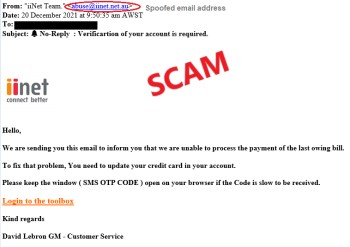In the digital age, scamming has become all too common. The latest victims? Customers of iiNet and Telstra, who are being targeted by an insidious email phishing scam.
This scam, alarmingly sophisticated, seeks to pilfer credit card details through the use of spoofed emails and false claims of payment issues.

Unmasking the Scam
Here’s how the perpetrators operate. They send out emails masquerading as official communications from iiNet or Telstra. These emails cleverly mimic the genuine email addresses of these telcos, making them appear all the more convincing.
The email declares that there’s been a hiccup with the most recent bill payment and provides a link to rectify the issue. But beware – this link is a trap. It directs victims to a fraudulent version of the telco’s login page, designed to phish for account information and credit card details.
Be Informed, Be Protected
So, what red flags should you be on the lookout for?
- Emails addressed generically, such as “Dear Customer”.
- Poorly constructed emails riddled with grammatical errors, spelling mistakes or broken sentences.
- Account information in the email that doesn’t match your provider’s records.
- Requests for your credit card details, passwords, account information, or personal data – typically by urging you to “click a link” and complete a web form.
- URLs that raise suspicion, or ones that don’t lead directly back to the telco provider’s website.
What If You’ve Clicked on a Suspicious Link?
Don’t panic. Here’s what you need to do:
- Refrain from entering any data into the web form.
- Run a thorough anti-virus scan on your device.
- Report the scam to your telco provider immediately.
- Inform your bank if you’ve inadvertently revealed your credit card details to the scammers.
- Contact ID Care if you’ve disclosed personal information.
Stay vigilant. Stay informed. And remember, when it comes to protecting yourself from scams, knowledge is your best defense.
Rreport scams to OzScamWatchers.com to help protect the community.